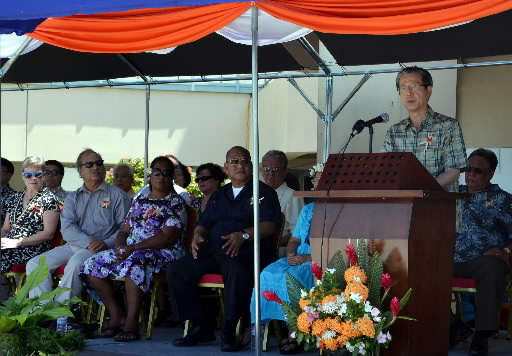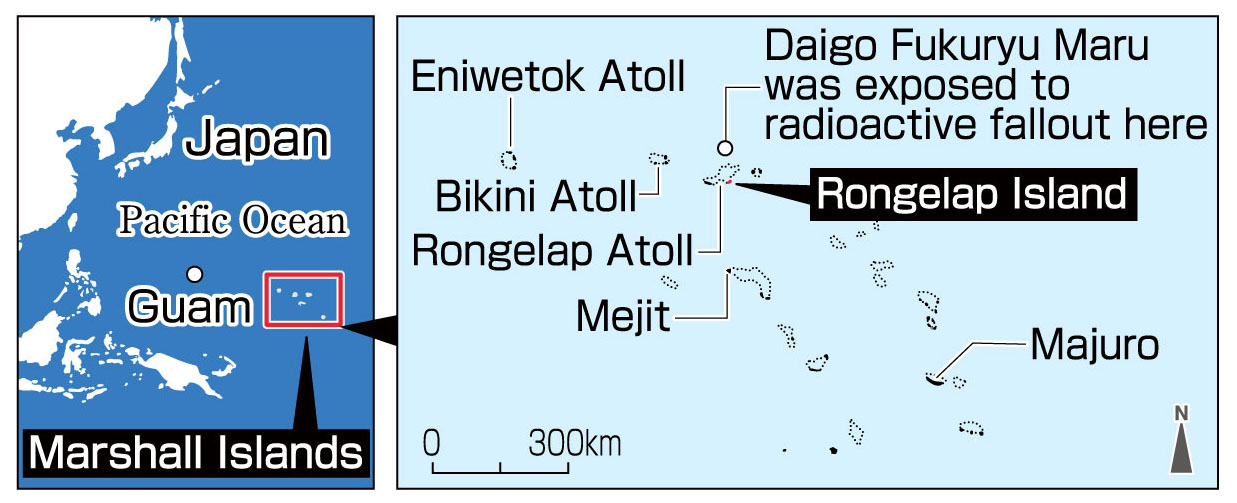With remembrance and resolve, ceremony commemorates 60th year of hydrogen bomb test at Bikini Atoll
Mar. 6, 2014
by Jumpei Fujimura, Staff Writer
Majuro, Marshall Islands – March 1 marked the 60th anniversary of the hydrogen bomb test conducted by the United States at Bikini Atoll in the Marshall Islands, in which crew members of the Japanese tuna fishing boat, known as the Daigo Fukuryu Maru (Lucky Dragon No. 5), and local residents of the area were exposed to radioactive fallout. On this day, a memorial ceremony organized by the government of the Marshall Islands was held in Majuro, the capital. The participants, including Matashichi Oishi, 80, a Tokyo resident and crew member of the fishing boat who was exposed to radioactive fallout, former islanders, and members of bereaved families, gathered to pray for a world without nuclear weapons.
At the venue, a plaza in front of the Capitol Building, about 400 people, including President Christopher Loeak, took part in the ceremony. The participants offered a minute of silence to the victims. Representatives from autonomous bodies on the four atolls, which have been recognized as places of radioactive contamination, then made remarks, recalling the suffering that has resulted from internal exposure to radiation and the history of struggle where there was no choice but to leave their stricken homelands.
Yasuyoshi Komizo, chairperson of the Hiroshima Peace Culture Foundation, represented the City of Hiroshima and attended the ceremony for the first time in an official capacity. Relating the anger and desire for peace held by A-bomb survivors, he called on the participants to continue making efforts together to realize a world without nuclear weapons.
Mr. Oishi, who made this trip to the Marshall Islands for the first time in 10 years, addressed the audience, too, saying, “The people of the Marshall Islands were sacrificed to make nuclear weapons. The nation that caused this damage must compensate the victims. I am opposed to both nuclear weapons and nuclear power plants.”
From the United States, Rose Gottemoeller, Acting Under Secretary of State for Arms Control and International Security, attended the ceremony. She reiterated that nation’s expected stance, saying that the nuclear tests carried out in the Marshall Islands contributed to global security and that the United States shares the goal of a world without nuclear arms.
At the end of the ceremony, messages from Hiroshima Mayor Kazumi Matsui, calling for united action to abolish nuclear weapons, and from Hiroshima Governor Hidehiko Yuzaki were read out.
From Japan, students at Hiroshima City University, which has organized a workshop here where young people from various parts of the world that have suffered nuclear damage can share their views, and college students from Fukushima Prefecture, where the accident at the Fukushima No. 1 (Daiichi) nuclear power plant took place, also attended the ceremony. Kai Sato, 25, a second-year graduate student at the Graduate School of Fukushima University, said, “I had the chance to reflect on the future of Fukushima in 60 years. It gave me the courage to overcome the hardships ahead.”
Keywords
Nuclear tests conducted in the Marshall Islands
The United States carried out 67 atomic and hydrogen bomb tests from 1946 through 1958 on the two atolls of Bikini and Enewetak in the Marshall Islands, located in the Pacific Ocean. (One test was conducted in the air over the islands.) Most notably, the “Castle Bravo” hydrogen bomb test at Bikini Atoll in 1954 released a large amount of nuclear fallout into the atmosphere. The explosive power of the bomb was 15 megatons, which is 1,000 times as powerful as the atomic bomb dropped on Hiroshima. Residents of Rongelap Atoll, located downwind, were exposed to radiation since no evacuation warning was issued in advance. Crew members of the Daigo Fukuryu Maru (Lucky Dragon No. 5), a Japanese tuna fishing boat, were also exposed to radioactive fallout. Aikichi Kuboyama, the chief radio operator of the boat, died six months later. Radioactive fallout contaminated many fishing boats, and many tuna had to be disposed of. It has been learned from official U.S. documents that an extensive area, including the U.S. mainland and Japan, was contaminated by radioactivity. Bikini Atoll was designated a UNESCO World Heritage site in 2010.
(Originally published on March 2, 2014)
Majuro, Marshall Islands – March 1 marked the 60th anniversary of the hydrogen bomb test conducted by the United States at Bikini Atoll in the Marshall Islands, in which crew members of the Japanese tuna fishing boat, known as the Daigo Fukuryu Maru (Lucky Dragon No. 5), and local residents of the area were exposed to radioactive fallout. On this day, a memorial ceremony organized by the government of the Marshall Islands was held in Majuro, the capital. The participants, including Matashichi Oishi, 80, a Tokyo resident and crew member of the fishing boat who was exposed to radioactive fallout, former islanders, and members of bereaved families, gathered to pray for a world without nuclear weapons.
At the venue, a plaza in front of the Capitol Building, about 400 people, including President Christopher Loeak, took part in the ceremony. The participants offered a minute of silence to the victims. Representatives from autonomous bodies on the four atolls, which have been recognized as places of radioactive contamination, then made remarks, recalling the suffering that has resulted from internal exposure to radiation and the history of struggle where there was no choice but to leave their stricken homelands.
Yasuyoshi Komizo, chairperson of the Hiroshima Peace Culture Foundation, represented the City of Hiroshima and attended the ceremony for the first time in an official capacity. Relating the anger and desire for peace held by A-bomb survivors, he called on the participants to continue making efforts together to realize a world without nuclear weapons.
Mr. Oishi, who made this trip to the Marshall Islands for the first time in 10 years, addressed the audience, too, saying, “The people of the Marshall Islands were sacrificed to make nuclear weapons. The nation that caused this damage must compensate the victims. I am opposed to both nuclear weapons and nuclear power plants.”
From the United States, Rose Gottemoeller, Acting Under Secretary of State for Arms Control and International Security, attended the ceremony. She reiterated that nation’s expected stance, saying that the nuclear tests carried out in the Marshall Islands contributed to global security and that the United States shares the goal of a world without nuclear arms.
At the end of the ceremony, messages from Hiroshima Mayor Kazumi Matsui, calling for united action to abolish nuclear weapons, and from Hiroshima Governor Hidehiko Yuzaki were read out.
From Japan, students at Hiroshima City University, which has organized a workshop here where young people from various parts of the world that have suffered nuclear damage can share their views, and college students from Fukushima Prefecture, where the accident at the Fukushima No. 1 (Daiichi) nuclear power plant took place, also attended the ceremony. Kai Sato, 25, a second-year graduate student at the Graduate School of Fukushima University, said, “I had the chance to reflect on the future of Fukushima in 60 years. It gave me the courage to overcome the hardships ahead.”
Keywords
Nuclear tests conducted in the Marshall Islands
The United States carried out 67 atomic and hydrogen bomb tests from 1946 through 1958 on the two atolls of Bikini and Enewetak in the Marshall Islands, located in the Pacific Ocean. (One test was conducted in the air over the islands.) Most notably, the “Castle Bravo” hydrogen bomb test at Bikini Atoll in 1954 released a large amount of nuclear fallout into the atmosphere. The explosive power of the bomb was 15 megatons, which is 1,000 times as powerful as the atomic bomb dropped on Hiroshima. Residents of Rongelap Atoll, located downwind, were exposed to radiation since no evacuation warning was issued in advance. Crew members of the Daigo Fukuryu Maru (Lucky Dragon No. 5), a Japanese tuna fishing boat, were also exposed to radioactive fallout. Aikichi Kuboyama, the chief radio operator of the boat, died six months later. Radioactive fallout contaminated many fishing boats, and many tuna had to be disposed of. It has been learned from official U.S. documents that an extensive area, including the U.S. mainland and Japan, was contaminated by radioactivity. Bikini Atoll was designated a UNESCO World Heritage site in 2010.
(Originally published on March 2, 2014)









